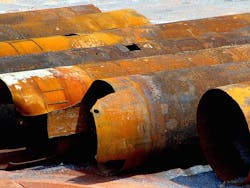NACE Intl. released the “International Measures of Prevention, Application and Economics of Corrosion Technology (IMPACT)” study, in which it estimates the global cost of corrosion to be $2.5 trillion, equivalent to roughly 3.4% of the global Gross Domestic Product (GDP). The two-year global study released at the Corrosion 2016 conference in Vancouver, B.C., examined the economics of corrosion and the role of corrosion management in establishing industry best practices. The study found that implementing corrosion prevention best practices could result in global savings of between 15% and 35% of the cost of damage, or between $375 and $875 billion.
“The IMPACT study reinforces what recent news headlines have made all too clear: there needs to be a change in how corrosion decisions are made,” said Bob Chalker, CEO of NACE Intl. “Whether it is a pipeline, an airplane, a water treatment plant or highway bridge, corrosion prevention and control is essential to avoiding catastrophic events before it’s too late.”
Looking beyond corrosion’s cost to businesses and industries worldwide, IMPACT assessed corrosion management practices across various industries and regions. Specifically, the study examined the oil and gas, pipeline, and drinking and wastewater industries, as well as the U.S. Department of Defense.
IMPACT also includes a case study of corrosion management within the automobile industry, which it found over time saved $9.6 billion or 52% annually in 1999 compared to 1975. “Looking at the success within the auto industry, corrosion prevention decisions were made at the highest levels,” said Chalker. “The result has been lower corrosion costs for auto makers and longer lasting autos for consumers.”
Corrosion management systems (CMS) address the threat of corrosion for existing and future assets across the complete lifecycle of the asset, from design to decommissioning. The IMPACT Study notes CMS best practices for companies including: corrosion management systems that are integrated with organization policy overall; corrosion management information is made available to everyone within the organization and linked to its overall goals; and organizational leadership is actively involved in corrosion management decision making.
The study also identified the need for more corrosion management professionals, given there is a significant wave of retirements in this area projected in the next decade. In fact, University of Akron in Ohio provides the only bachelor’s degree in corrosion engineering, with its first class graduating in 2015.
“There needs to be a renewed sense of priority for corrosion engineering among employers and educators,” said Jim Feather, NACE Intl. president. “NACE has provided training and professional development to tens of thousands of engineers and professionals in more than 130 countries, but the industry needs more academic programs and more universal means of communications across all levels of business.”
To learn more and view the IMPACT study in its entirety, visit impact.nace.org.
Source: NACE


